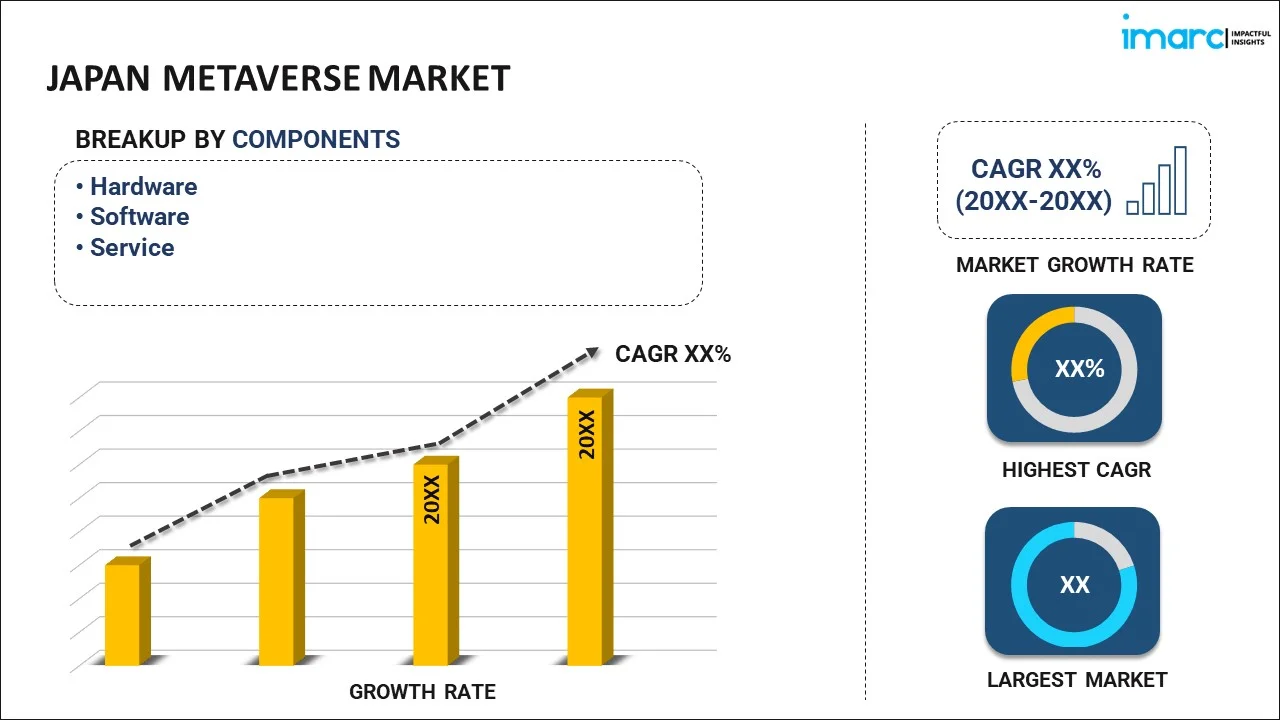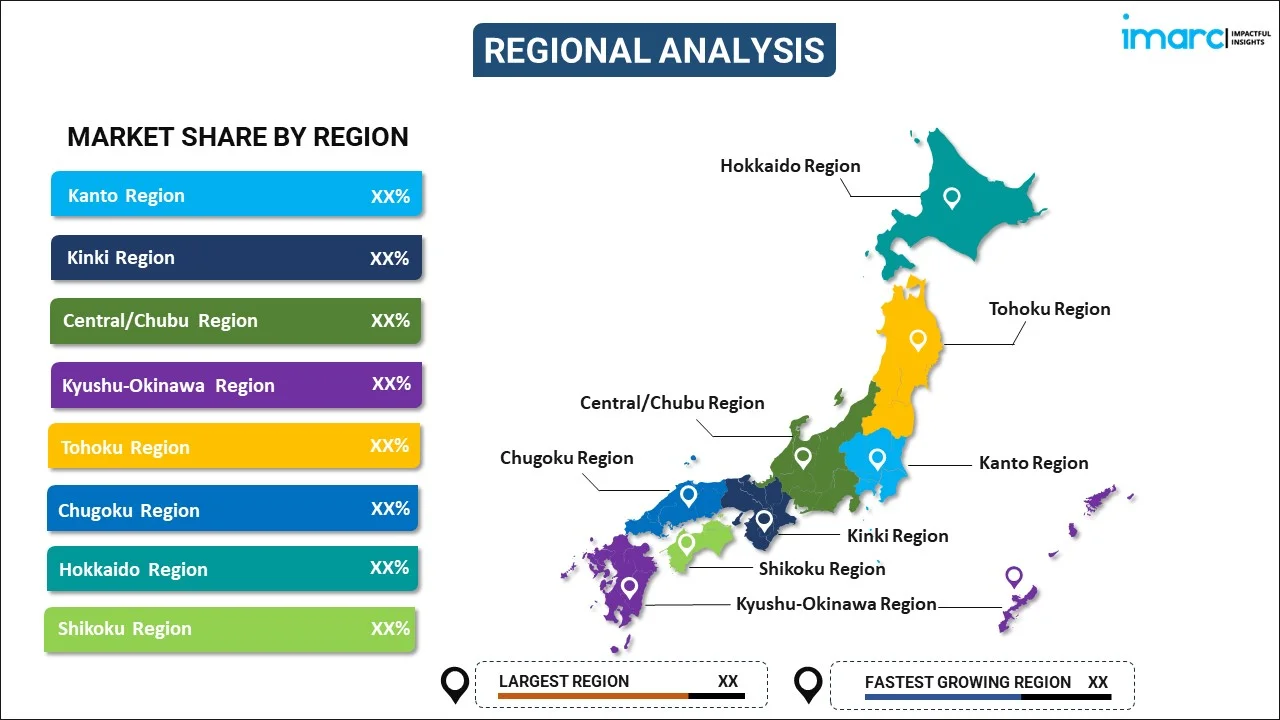
Japan Metaverse Market Report by Component (Hardware, Software, Service), Technology (Blockchain, Virtual Reality and Augmented Reality, Mixed Reality, and Others), Application (Gaming, Online Shopping, Content Creation and Social Media, Events and Conference, Digital Marketing, Testing and Inspection, and Others), Industry Vertical (BFSI, Retail, Media and Entertainment, Education, Aerospace and Defense, Automotive, and Others), and Region 2025-2033
Market Overview:
The Japan metaverse market size reached USD 7.8 Billion in 2024. Looking forward, IMARC Group expects the market to reach USD 111.0 Billion by 2033, exhibiting a growth rate (CAGR) of 34.2% during 2025-2033. The penetration of high-speed internet, the integration with digital and virtual technologies in various sectors, and the rise in strategic collaborations among leading players across the country represent some of the key factors driving the market.
|
Report Attribute
|
Key Statistics
|
|---|---|
|
Base Year
|
2024 |
|
Forecast Years
|
2025-2033
|
|
Historical Years
|
2019-2024
|
| Market Size in 2024 | USD 7.8 Billion |
| Market Forecast in 2033 | USD 111.0 Billion |
| Market Growth Rate (2025-2033) | 34.2% |
The metaverse refers to a virtual environment where users may communicate with other users and a computer-generated world in real time. It's essentially a collective virtual shared space created by the convergence of physically virtually enhanced reality, augmented reality (AR), virtual reality (VR), and the internet. This universe, accessible via the internet, is built on a blockchain technology platform, which allows for the development, possession, and exchange of digital assets. It includes multiple virtual universes, each having its own physics and rules, built and maintained by its participants. Additionally, it can be considered an immersive digital world where individuals can interact with each other and software agents in a three-dimensional (3D) space. It's not just a virtual reality but a reality modelled on the physical world, presenting opportunities for work, learning, and entertainment. One of the key characteristics of the metaverse is its vastness and scalability. It is designed to be a seamless and interconnected network of virtual spaces, allowing users to move between different environments, activities, and experiences without constraints. These virtual spaces can range from realistic simulations of real-world locations to entirely fictional and fantastical landscapes, providing users with diverse and boundless opportunities for exploration and interaction.
Japan Metaverse Market Trends:
Japan's strong technological infrastructure and a culture that embraces digital innovation majorly drive the market. Along with this, the increasing prevalence of high-speed internet, 5G technology, and advanced hardware devices are providing the necessary infrastructure for the development and expansion of the Metaverse in Japan. In addition, the growing interest in online gaming, virtual reality, and augmented reality, fueled by the impact of the COVID-19 pandemic, has escalated the move towards the Metaverse. Moreover, the integration of these digital and virtual technologies in various sectors, such as entertainment, retail, and education, has expanded the potential applications of the Metaverse in the Japanese market. Additionally, the Japanese market is witnessing a rise in strategic collaborations and investments in the Metaverse space. Tech giants and gaming companies are actively investing in Metaverse platforms, demonstrating their commitment to this digital frontier. Apart from this, the rising trend of NFTs (Non-Fungible Tokens) in Japan, acting as digital certificates of ownership in the Metaverse, is fostering the market's growth. Simultaneously, regulatory bodies in Japan are keenly observing the developments in the Metaverse space to ensure consumer safety and fair trade practices. Furthermore, the societal acceptance of virtual avatars and virtual life in Japan is creating a positive market outlook.
Japan Metaverse Market Segmentation:
IMARC Group provides an analysis of the key trends in each segment of the Japan metaverse market report, along with forecasts at the country level for 2025-2033. Our report has categorized the market based on component, technology, application, and industry vertical.
Component Insights:

- Hardware
- Software
- Service
The report has provided a detailed breakup and analysis of the market based on the component. This includes hardware, software, and service.
Technology Insights:
- Blockchain
- Virtual Reality and Augmented Reality
- Mixed Reality
- Others
A detailed breakup and analysis of the market based on the technology has also been provided in the report. This includes blockchain, virtual reality and augmented reality, mixed reality, and others.
Application Insights:
- Gaming
- Online Shopping
- Content Creation and Social Media
- Events and Conference
- Digital Marketing
- Testing and Inspection
- Others
The report has provided a detailed breakup and analysis of the market based on the application. This includes gaming, online shopping, content creation and social media, events and conference, digital marketing, testing and inspection, and others.
Industry Vertical Insights:
- BFSI
- Retail
- Media and Entertainment
- Education
- Aerospace and Defense
- Automotive
- Others
A detailed breakup and analysis of the market based on the industry vertical has also been provided in the report. This includes BFSI, retail, media and entertainment, education, aerospace and defense, automotive, and others.
Regional Insights:

- Kanto Region
- Kinki Region
- Central/ Chubu Region
- Kyushu-Okinawa Region
- Tohoku Region
- Chugoku Region
- Hokkaido Region
- Shikoku Region
The report has also provided a comprehensive analysis of all the major regional markets, which include Kanto Region, Kinki Region, Central/ Chubu Region, Kyushu-Okinawa Region, Tohoku Region, Chugoku Region, Hokkaido Region, and Shikoku Region.
Competitive Landscape:
The report has also provided a comprehensive analysis of the competitive landscape in the market. Competitive analysis such as market structure, key player positioning, top winning strategies, competitive dashboard, and company evaluation quadrant has been covered in the report. Also, detailed profiles of all major companies have been provided.
Japan Metaverse Market Report Coverage:
| Report Features | Details |
|---|---|
| Base Year of the Analysis | 2024 |
| Historical Period | 2019-2024 |
| Forecast Period | 2025-2033 |
| Units | Billion USD |
| Scope of the Report | Exploration of Historical and Forecast Trends, Industry Catalysts and Challenges, Segment-Wise Historical and Predictive Market Assessment:
|
| Components Covered | Hardware, Software, Service |
| Technologies Covered | Blockchain, Virtual Reality and Augmented Reality, Mixed Reality, Others |
| Applications Covered | Gaming, Online Shopping, Content Creation and Social Media, Events and Conference, Digital Marketing, Testing and Inspection, Others |
| Industry Verticals Covered | BFSI, Retail, Media and Entertainment, Education, Aerospace and Defense, Automotive, Others |
| Regions Covered | Kanto Region, Kinki Region, Central/ Chubu Region, Kyushu-Okinawa Region, Tohoku Region, Chugoku Region, Hokkaido Region, Shikoku Region |
| Customization Scope | 10% Free Customization |
| Post-Sale Analyst Support | 10-12 Weeks |
| Delivery Format | PDF and Excel through Email (We can also provide the editable version of the report in PPT/Word format on special request) |
Key Questions Answered in This Report:
- How has the Japan metaverse market performed so far and how will it perform in the coming years?
- What has been the impact of COVID-19 on the Japan metaverse market?
- What is the breakup of the Japan metaverse market on the basis of component?
- What is the breakup of the Japan metaverse market on the basis of technology?
- What is the breakup of the Japan metaverse market on the basis of application?
- What is the breakup of the Japan metaverse market on the basis of industry vertical?
- What are the various stages in the value chain of Japan metaverse market?
- What are the key driving factors and challenges in the Japan metaverse market?
- What is the structure of the Japan metaverse market and who are the key players?
- What is the degree of competition in the Japan metaverse market?
Key Benefits for Stakeholders:
- IMARC’s report offers a comprehensive quantitative analysis of various market segments, historical and current market trends, market forecasts, and dynamics of the Japan metaverse market from 2019-2033.
- The research study provides the latest information on the market drivers, challenges, and opportunities in the Japan metaverse market.
- Porter's five forces analysis assist stakeholders in assessing the impact of new entrants, competitive rivalry, supplier power, buyer power, and the threat of substitution. It helps stakeholders to analyze the level of competition within the Japan metaverse industry and its attractiveness.
- Competitive landscape allows stakeholders to understand their competitive environment and provides an insight into the current positions of key players in the market.
Need more help?
- Speak to our experienced analysts for insights on the current market scenarios.
- Include additional segments and countries to customize the report as per your requirement.
- Gain an unparalleled competitive advantage in your domain by understanding how to utilize the report and positively impacting your operations and revenue.
- For further assistance, please connect with our analysts.
 Inquire Before Buying
Inquire Before Buying
 Speak to an Analyst
Speak to an Analyst
 Request Brochure
Request Brochure
 Request Customization
Request Customization




.webp)




.webp)












